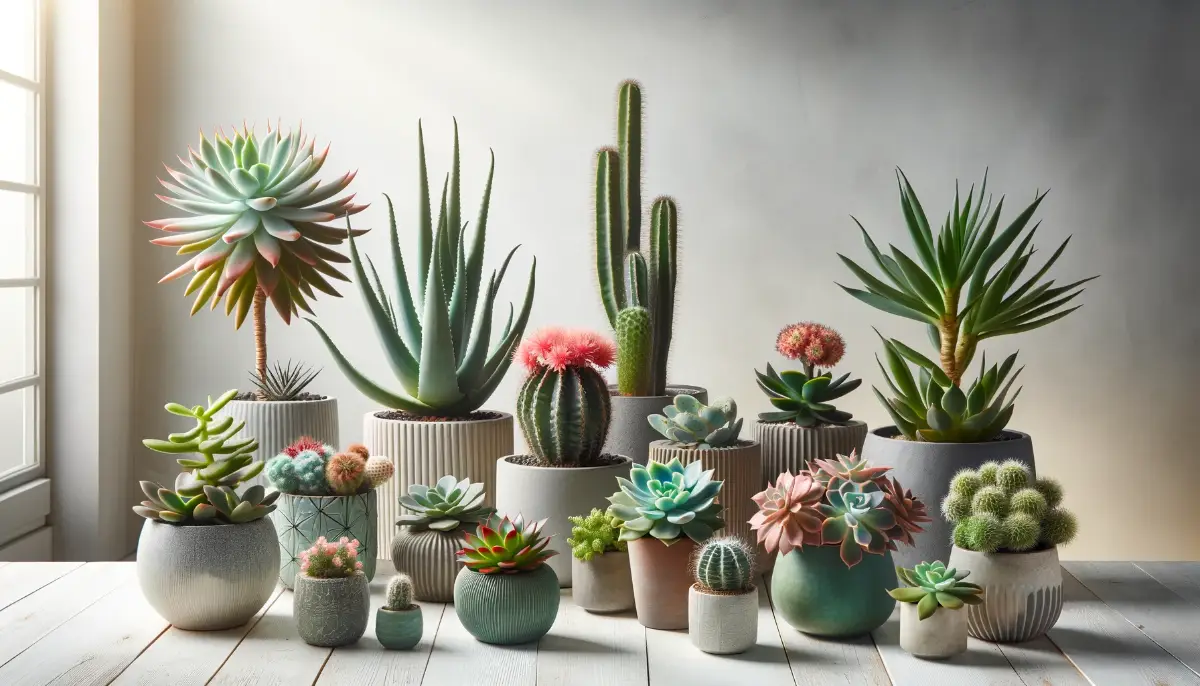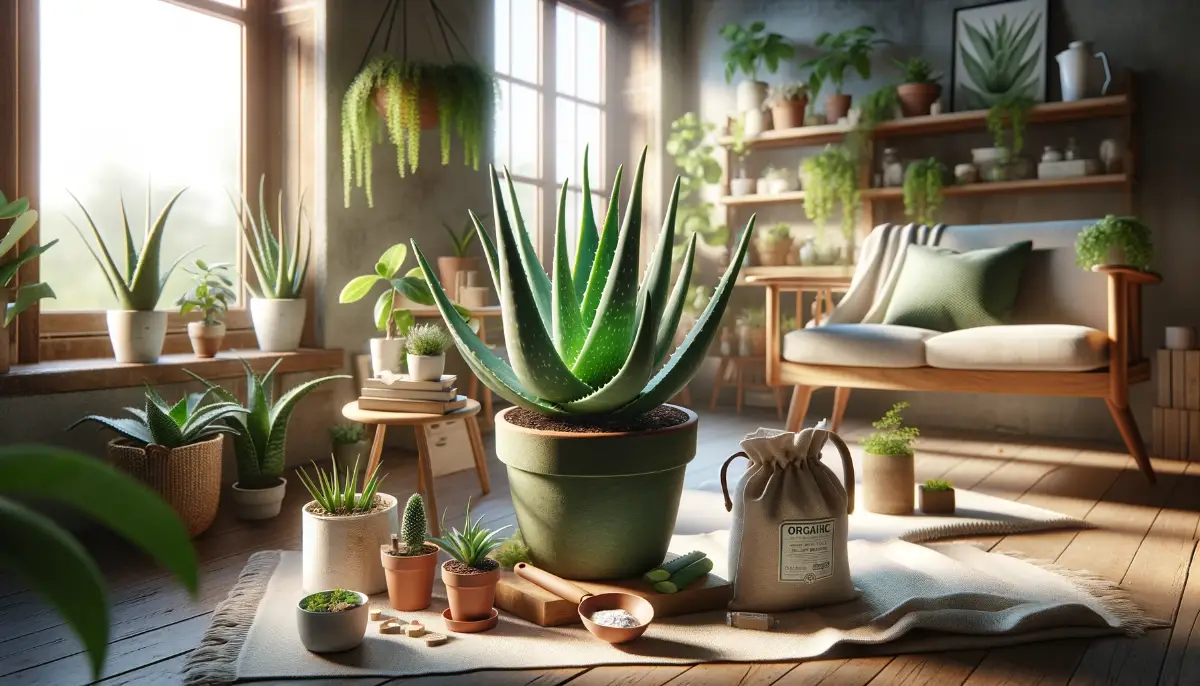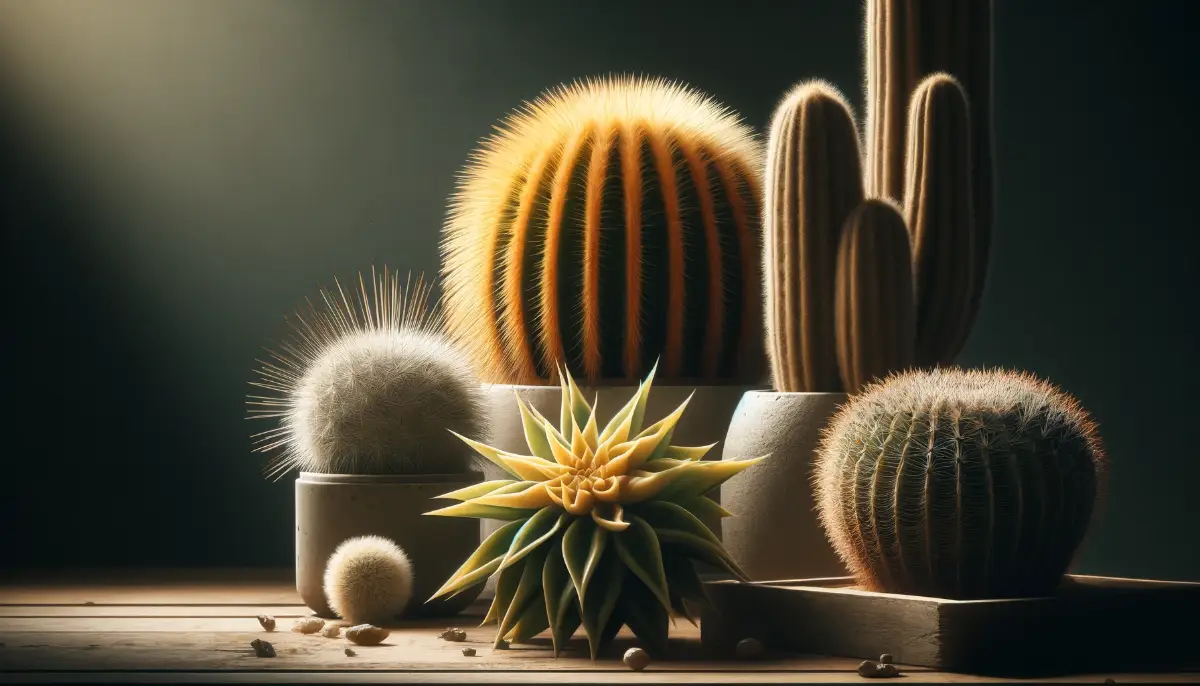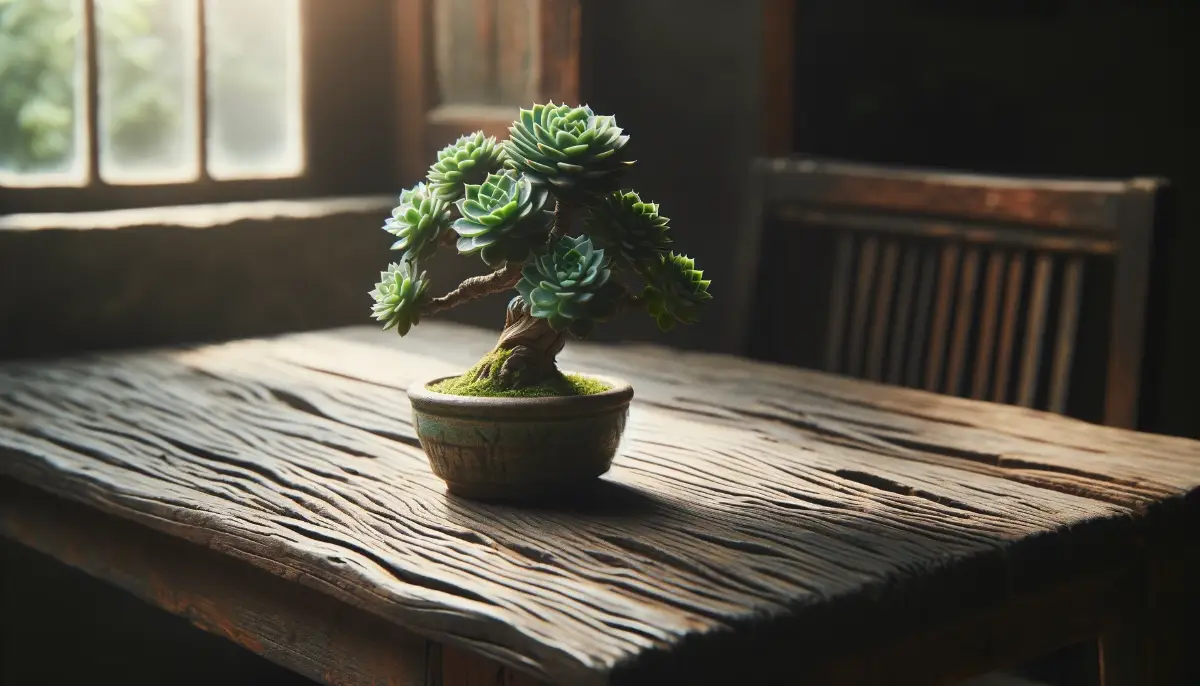Succulents are not just trendy decor; they’re the ultimate easy-care plants, perfect for both gardening novices and those looking to add a touch of green with minimal fuss.
These plants, known for their ability to store water in their leaves, stems, or roots, are tailor-made for busy lifestyles and less-than-ideal plant conditions typically found in our homes and offices.
Whether you’re situated in a sun-drenched house or a cozy, low-light apartment, there’s a succulent just right for your space, ready to bring a bit of nature indoors.
- Succulents store water in their fleshy leaves, making them drought-resistant.
- They require minimal watering and thrive in well-draining soil.
- Most succulents need bright, indirect sunlight to grow properly.
Understanding Succulents
Succulents are fascinating plants, primarily characterized by their ability to store water in their leaves, stems, or roots. This unique feature allows them to thrive in arid climates and soil conditions where other plants might struggle.
Succulents have thick, fleshy parts that are adapted to retain moisture, a crucial trait that enables them to withstand prolonged dry periods. Unlike other plant types, succulents can vary widely in appearance, from flat, rounded leaves to spiky or ridged textures, each adapted to specific environmental conditions.
Most succulents enjoy plenty of sunlight and require soil with excellent drainage. They are often found in desert or semi-desert regions, rocky terrains, and even as epiphytes in some jungle regions.
What sets succulents apart from other plants is not just their water-storing abilities but also their diverse forms and sizes, which make them particularly popular for decorative purposes in homes and gardens.
Types of Popular Succulents
Succulents come in an array of types, each with unique features and care needs that make them favorites among plant enthusiasts. Here are some of the most popular types:
- Aloe Vera
Known for its medicinal properties, Aloe vera features thick, gel-filled leaves. It’s particularly famous for soothing skin irritations like sunburns. This succulent prefers bright, indirect sunlight and moderate watering.
- Cacti
Cacti are probably the first plants that come to mind when thinking of succulents. They’re distinguished by their spiky surface and lack of visible leaves, which helps reduce water loss. Most cacti thrive in a hot, sunny environment.
- Jade Plant (Crassula ovata)
Jade plants have thick, woody stems and oval-shaped leaves that can develop a red tinge around the edges under sufficient light conditions. They need a mix of sun and partial shade, along with infrequent watering to mimic their natural, dry habitat.
- Echeveria
Echeverias are loved for their beautiful rosette shape and colorful leaves that can range from blue-green to pinkish-purple. They require strong light to maintain their color and compact rosette form.
- Sedum
Sedums, or “stonecrop,” are easy to care for and grow quickly, making them a great choice for beginners. They prefer plenty of sunlight and are drought tolerant, perfect for xeriscaping.
- Kalanchoe
This genus includes the widely known Flaming Katy, which blooms small, vibrant flowers. Kalanchoes need plenty of light and minimal watering, with a preference for warm environments.
- Sempervivum (Hens and Chicks)
Sempervivum plants are perfect for outdoor succulent gardens as they tolerate cold and drought. Known as “hens and chicks” due to their ability to produce numerous offsets, they are ideal for ground covers.
These varieties showcase the diversity and adaptability of succulents, making them suitable for different indoor and outdoor settings. Proper care, tailored to each type’s specific needs, will ensure they thrive and beautify any space.
Selecting the Right Succulent for Your Home
Selecting the right succulent for your home involves considering the specific care requirements of each variety and matching them with your home environment and lifestyle. Here’s a guide to help you choose the best succulent for your space:
Consider Light Availability
- Bright Light: Most succulents thrive in bright light. South-facing windows are ideal for plants like Echeverias and Cacti that need plenty of sunlight.
- Low Light: If your space doesn’t receive a lot of sunlight, opt for succulents like Zebra plants (Haworthia) or Snake plants, which can adapt to lower light conditions.
Assess Your Care Commitment
- Low Maintenance: If you prefer plants that don’t require frequent care, choose varieties like Jade plants or Aloe vera, which need minimal watering and attention.
- More Careful Monitoring: Succulents like Kalanchoe or certain types of Cacti might bloom and show their best colors with a bit more care and occasional fertilizing.
Space Considerations
- Small Spaces: Compact succulents like Haworthias or small Echeverias are perfect for limited spaces such as windowsills or small shelves.
- Larger Displays: If you have more space, consider larger succulents like Aloe vera or grouping several succulents together for a varied display.
Humidity and Temperature
- Warmer Climates: Most succulents prefer warmer temperatures but be wary of direct sunlight exposure which can scorch some types, such as certain Cacti and Echeverias.
- Colder Climates: Sempervivum and some Sedum species are cold-hardy and can even be kept outdoors in colder weather.
Personal Aesthetic Preference
- Colorful Varieties: For a vibrant display, choose succulents with colorful leaves such as various types of Kalanchoe or Echeverias.
- Unique Textures: Succulents like Aloe, with their spiky appearance, or fuzzy succulents like certain Kalanchoe species offer interesting textures.
Choosing the right succulent involves understanding the specific needs of each type and how well they can adapt to your home’s conditions. This ensures not only the health of the plants but also your enjoyment and success in growing them.
Soil and Repotting Essentials
Choosing the right soil and understanding repotting essentials are crucial for the health and growth of succulents. Here’s a guide to ensure your succulents thrive:
Choosing the Right Soil
- Well-Draining Soil: Succulents require well-draining soil to prevent water from pooling around the roots, which can lead to root rot. A cactus or succulent potting mix is ideal because it typically contains a mix of soil, coarse sand, and perlite or pumice, which helps improve drainage.
- DIY Mixes: If you prefer to make your own succulent soil, mix one part potting soil with one part perlite or coarse sand to enhance drainage. Some gardeners also add small amounts of compost for added nutrients, but this should be done sparingly to avoid retaining too much moisture.
Repotting Essentials
- When to Repot: Succulents should generally be repotted every two years or when they outgrow their current container. It’s best to repot during the succulent’s active growing season, which is usually in the spring or early summer.
- Choosing a Pot: Select a new pot that is slightly larger than the old one, ensuring it has adequate drainage holes. Avoid pots that are too large as this can lead to excess soil moisture which is detrimental to succulent health.
- Repotting Process:
- Remove the Plant: Gently take the succulent out of its current pot, shaking off old soil and checking the roots for any signs of rot.
- Prepare the New Pot: Place a layer of succulent potting mix at the bottom of the new pot.
- Position the Plant: Place the succulent in the new pot and fill around it with potting mix, pressing lightly to secure the plant.
- Watering After Repotting: Wait a few days to water the succulent to reduce the risk of root rot while the roots adjust to their new environment.
Aftercare
- After repotting, keep the succulent in a bright area but out of direct sunlight for a few days to allow it to recover. Gradually reintroduce it to its usual environment, monitoring for any signs of stress.
Proper soil selection and careful repotting can significantly impact the health of your succulents, helping them to grow robustly and remain healthy.
Understanding Water Needs
Soil Check: Succulents require dry conditions to thrive. Before watering, check that the top inch of soil is dry. If it’s still moist, wait a few more days before checking again.
Frequency: Generally, succulents need to be watered less frequently than other plants. In warmer months, watering might be necessary once every 7-10 days, while in cooler months, it can reduce to once every 2-3 weeks depending on the humidity and temperature of your environment.
Proper Watering Technique
- Deep Watering: When you water, do so deeply. This means watering until moisture comes out of the drainage holes at the bottom of the pot. This encourages roots to grow downward, stabilizing your plant.
- Avoid Leaves and Stems: Try to water the soil directly, avoiding the leaves and stems. Water remaining on the leaves can cause rot or fungal diseases, especially in less ventilated environments.
- Best Time to Water: Water your succulents early in the morning. This allows any water that gets on the leaves to evaporate throughout the day, reducing the risk of moisture-related problems.
Adjusting to Seasons
- Seasonal Adjustments: Adjust your watering habits based on the season. Succulents grow actively in spring and summer; during these seasons, they’ll need more frequent watering. In fall and winter, they enter a dormant phase and require less water.
- Environmental Factors: Be mindful of your local climate and indoor conditions. Succulents in a dry, hot climate may need more frequent watering than those in a cool, shady environment.
Signs of Improper Watering
- Overwatering: Signs include yellowing or mushy leaves and stem rot. This is the most common problem faced by succulent owners.
- Underwatering: Indicated by shriveled, dry leaves and stunted growth. If the plant looks deflated or puckered, it’s likely underwatered.
Using these techniques will help ensure your succulents receive the right amount of water without overdoing it, keeping them healthy and vibrant. Remember, the key to successful succulent care is more about the frequency of watering rather than the quantity.
How to Fertilizing Succulents
Fertilizing succulents is a nuanced task, as these plants are adapted to thrive in nutrient-poor environments. However, using organic fertilizers can gently boost their growth and vitality without overwhelming them. Here’s how to do it right:
Choosing the Right Organic Fertilizer
- Types of Organic Fertilizers: Opt for mild, organic options like worm castings, fish emulsion, or compost tea. These provide a balanced mix of nutrients without the harsh chemicals found in synthetic fertilizers.
- Low Nitrogen Content: It’s important to choose a fertilizer with low nitrogen content to prevent rapid foliage growth at the expense of root and flower development.
Fertilizing Frequency
- Growth Periods: Succulents should only be fertilized during their active growing season, which is typically from spring to early fall. During the dormant winter months, fertilizing should be halted to avoid harming the plant.
- Frequency: Fertilizing once per month during the growing season is sufficient. Over-fertilizing can damage the plants, so it’s crucial to follow the recommended dosage on the fertilizer packaging.
Application Tips
- Dilution Is Key: Always dilute your organic fertilizer to at least half the strength recommended for other plants. This is particularly important for succulents, which are sensitive to nutrient overload.
- How to Apply: Water your plant first to moisten the soil, which helps prevent root burn. Then apply the diluted organic fertilizer directly to the soil, avoiding the leaves and stems to prevent burns or fungal growth.
Observing Plant Response
- Monitor Plant Health: After applying fertilizer, keep an eye on your succulents for signs of distress, such as yellowing leaves or black spots, which can indicate over-fertilization. Similarly, observe for positive changes such as more robust growth or increased flower production, which indicate a beneficial response.
Using organic fertilizers with care allows you to nurture your succulents in a way that promotes their health without disrupting their natural hardiness.
Common Challenges and Solutions
Growing succulents can be a rewarding experience, but like any plant, they can encounter various challenges. Here are some common issues that succulent owners face and effective solutions for each:
Overwatering
- Problem: Overwatering is the most common issue with succulents, leading to root rot and fungal diseases.
- Solution: Ensure the soil is completely dry between waterings. Use a pot with good drainage and a soil mix that doesn’t retain excess moisture. Water less frequently during colder months.
Underwatering
- Problem: While succulents are drought-tolerant, too little water can cause them to shrivel and lose their vibrancy.
- Solution: Water your succulents deeply but infrequently, ensuring the water reaches the roots. During active growth periods, increase watering frequency slightly.
Lack of Light
- Problem: Succulents that don’t receive enough light can become etiolated, where they stretch towards the nearest light source and lose their compact shape.
- Solution: Place succulents in a location where they receive plenty of indirect sunlight. If natural light is insufficient, consider using a grow light to provide supplemental light.
Pests
- Problem: Common pests that affect succulents include mealybugs, spider mites, and aphids.
- Solution: Use a cotton swab dipped in alcohol to remove pests manually. For more severe infestations, apply insecticidal soap or neem oil, ensuring to follow application instructions carefully to avoid damaging the plant.
Temperature Stress
- Problem: Succulents can suffer from sudden temperature changes or extreme temperatures, leading to stress signs like dropping leaves or discolored spots.
- Solution: Keep succulents away from drafty windows in the winter and provide shade during the hottest parts of the day in summer. Gradually acclimate outdoor succulents to indoor conditions as seasons change.
Addressing these challenges promptly and adjusting care routines as needed can help ensure your succulents remain healthy and vibrant. Regular monitoring and adjustment of their care environment are key to preventing these issues from becoming serious problems.
FAQs about Caring for Succulents
How often should I water my succulents?
Water succulents once every 1-2 weeks, allowing the soil to dry completely between waterings. In winter, reduce watering frequency to once a month or less, depending on the humidity and temperature.
Do succulents need direct sunlight?
Most succulents prefer bright, indirect sunlight. Direct sunlight can sometimes be too intense and cause their leaves to sunburn, especially through a window. A few hours of direct sun, particularly in the morning, can be beneficial, depending on the species.
What is the best soil for succulents?
Use a well-draining soil mix designed for cacti and succulents. You can make your own by mixing potting soil with coarse sand, perlite, or pumice in a ratio of about 1:1.
How do I know if I’m overwatering my succulents?
Signs of overwatering include soft, mushy, and translucent leaves, or leaves that are falling off with minimal touch. The base of the plant may also appear brown or black and feel soft to the touch, indicating rot.
Can succulents survive in low light?
While succulents prefer bright light, some can survive in low light conditions. Varieties such as Zebra plant (Haworthia) and Snake plant (Sansevieria) are more tolerant of low light environments.
When should I repot my succulents?
Repot succulents every 2-3 years or when they outgrow their container. It’s best to repot in the spring, which is the start of their active growing season.
How can I propagate succulents?
Succulents can be propagated from leaves or stem cuttings. Gently twist a leaf from the stem, let it callous over for a few days, and then place it on top of soil until roots and new shoots appear.
What are common pests on succulents, and how can I deal with them?
Common pests include mealybugs, spider mites, and aphids. Treat infestations with a cotton swab dipped in alcohol or spray with insecticidal soap or neem oil.
Can succulents grow indoors?
Yes, many succulents are well-suited to indoor environments. Ensure they have enough light, preferably by placing them near a south or east-facing window.
How do I fertilize succulents?
Fertilize succulents sparingly, no more than once a month during the growing season, with a balanced, diluted (half strength) fertilizer. Avoid fertilizing in the winter when the plants are dormant.











